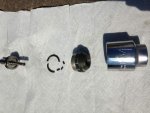- 10,457
- 6,530
- 113
- Location
- Camp Wood/LC, TX
I was in the process of raising the cab of the M1078, when just starting on the way up, the cab latch cylinder blew out, spraying hydraulic fluid all over the right side of the truck. The oil came from the indicator plunger, which we are supposed to look at to make sure the cab is latched down. Needless to say, I could no longer raise the cab. Fortunately I was at the shop, working out the zillions of other less catastrophic bugs these trucks seem to be plagued with. I would hate to think if I was on the side of the road somewhere, needing to check the oil or something. Anyway, it is a simple repair. The TMs only cover removing the latch cylinder assy, but this is not required. Get your 1 3/4 socket, open end wrench, or maybe even channellocks, and remove the aluminum cylinder end cap. Inside is the piston, which you can pull out with your fingers. On it you will find a 1 1/8" x 1/8" O-ring that is very brittle. O'Reilly's had a National p/n 216 O-ring which worked perfectly. $2.50. Problem solved. Picture shows the piston, the cylinder end cap, the broken O-ring, and the socket I used.
10 year later edit: The other o ring is a P16 metric o-ring. This is the one on the plunger shaft.
10 year later edit: The other o ring is a P16 metric o-ring. This is the one on the plunger shaft.
Attachments
-
41.5 KB Views: 427
-
34 KB Views: 15
Last edited:




